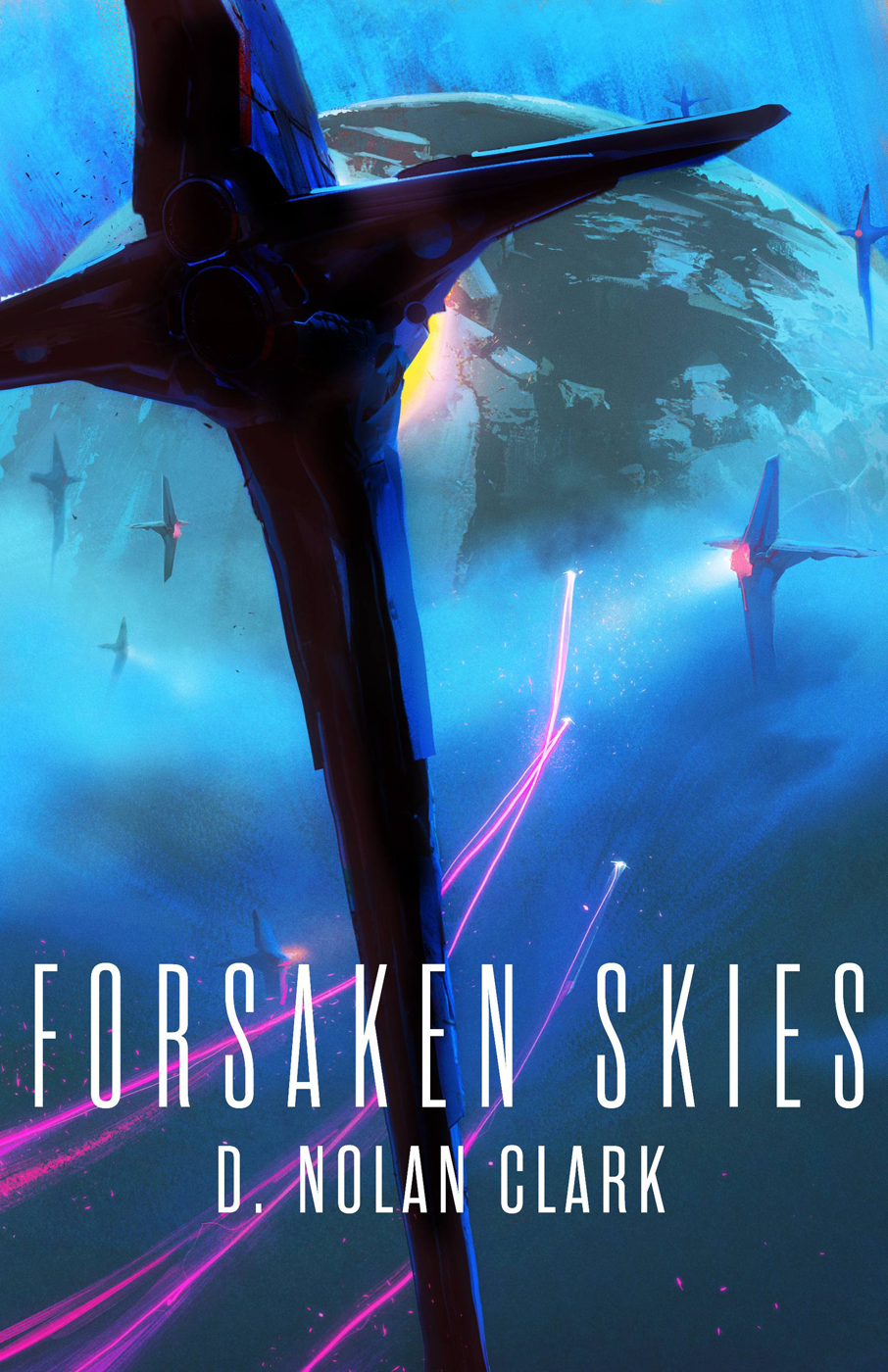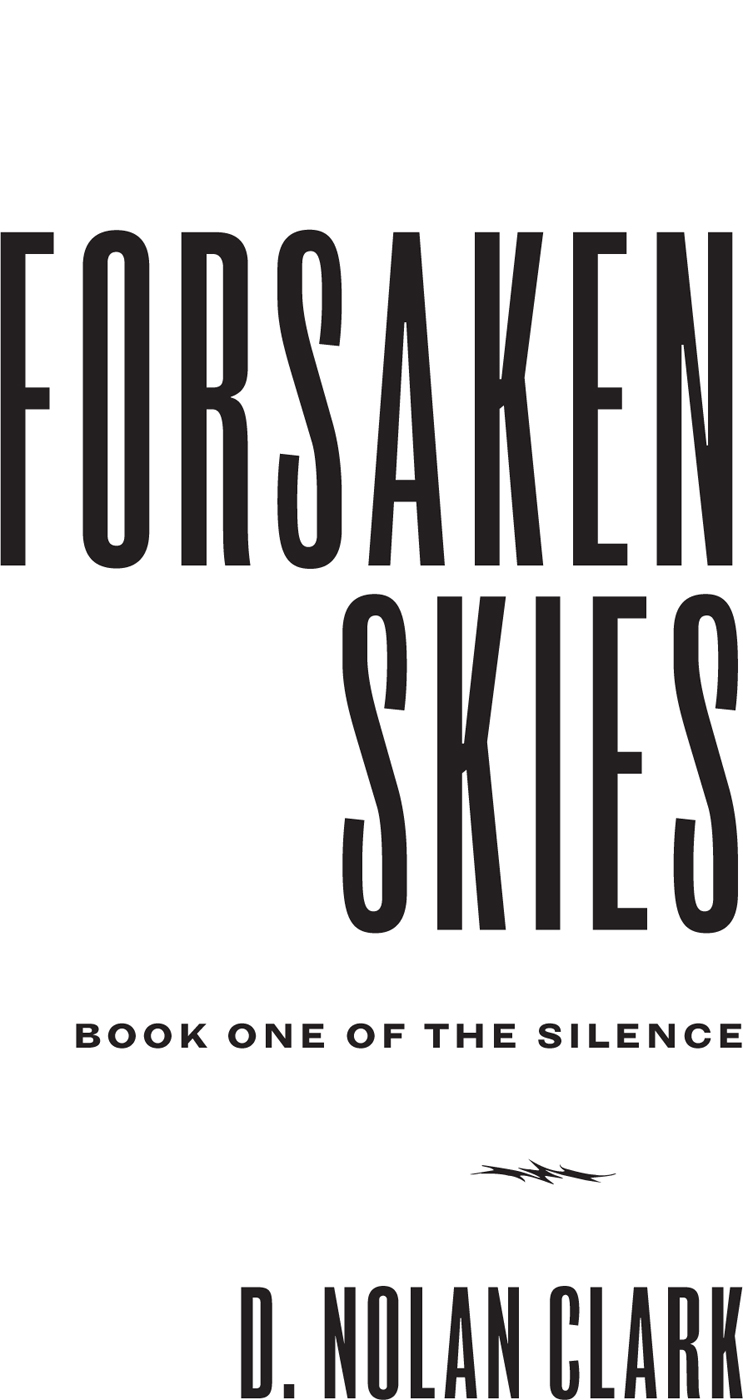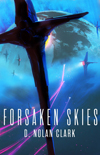Forsaken Skies
Authors: D. Nolan Clark



orbitbooks.net
orbitshortfiction.com
Hachette Book Group supports the right to free expression and the value of copyright. The purpose of copyright is to encourage writers and artists to produce the creative works that enrich our culture.
The scanning, uploading, and distribution of this book without permission is a theft of the author's intellectual property. If you would like permission to use material from the book (other than for review purposes), please contact [email protected]. Thank you for your support of the author's rights.
For Jennifer
F
lying down a wormhole was like throwing yourself into the center of a tornado, one where if you brushed the walls you would be obliterated down to subatomic particles before you even knew it happened.
Racing through a wormhole at this speed was suicide. But the kid wouldn't slow down.
Lanoe thumbed a control pad and painted the yacht's backside with a communications laser. A green pearl appeared in the corner of his vision, with data on signal strength rolling across its surface. “Thom,” he called. “Thom, you've got to stop this. I know you're scared, I knowâ”
“I killed him! I can't go back now!”
Lanoe muted the connection and focused for a second on not getting himself killed. The wormhole twisted and bent up ahead, warped where it passed under some massive gravity source, probably a star. Side passages opened in every direction, split by the curvature of spacetime. Lanoe had lost track of where, in real-space terms, they wereâthey'd started back at Xibalba but they could be a hundred light-years away by now. Wormspace didn't operate by Newtonian rules. They could be anywhere. They could theoretically be on the wrong end of the universe.
The yacht up ahead was still accelerating. It was a sleek spindle of darkness against the unreal light of the tunnel walls, all black carbon fiber broken only by a set of airfoils like flat wings spaced around its thruster. At his school Thom had a reputation as some kind of hotshot racerâhe was slated to compete in next year's Earth Cupâand Lanoe had seen how good a pilot the kid was as he chased him down. He was still surprised when Thom twisted around on his axis of flight and kicked in his maneuvering jets, nearly reversing his course and sending the yacht careening down one of the side tunnels.
Maybe he'd thought he could escape that way.
For all the kid's talent, though, Lanoe was Navy trained. He knew a couple of tricks they never taught to civilians. He switched off the compensators that protected his engine and pulled a right-hand turn tighter than a poly's purse. He squeezed his eyes shut as his inertial sink shoved him hard back into his seat but when he looked again he was right back on the yacht's tail. He thumbed for the comms laser again and when the green pearl popped up he said, “Thom, you can't outfly me. We need to talk about this. Your dad is dead, yes. We need to think about what comes next. Maybe you could tell me why you did itâ”
But the green pearl was gone. Thom had burned for another course change and surged ahead. He'd pulled out of the maze of wormspace and back into the real universe, up ahead at another dip in the spacetime curve.
Lanoe goosed his engine and followed. He burst out of the wormhole throat and into searing red light that burned his eyes.

Centrocor freight hauler 4519 approaching on vector 7, 4, â32.
Wilscon dismantler ship Angie B, you are deviating from course by .02. Advise.
Traffic control, this is Angie B, we copy. Burning to correct.
The whispering voices of the autonomic port monitors passed across Valk's consciousness without making much of an impression.
Orbital traffic control wasn't an exacting job. It didn't pay well, either. Valk didn't mind so much. There were fringe benefits. For one, he had a cramped little workstation all to himself. He valued his privacy. Moreover, at the vertex between two limbs of the Hexus there was no gravity. It helped with the pain, a little.
Valk had been in severe pain for the last seventeen years, ever since he'd suffered what he always called his “accident.” Even though there'd been nothing accidental about it. He had suffered severe burns over his entire body and even now, so many years later, the slightest weight on his flesh was too much.
His arms floated before him, his fingers twitching at keyboards that weren't really there. Lasers tracked his fingertip movements and converted them to data. Screens all around him pushed information in through his eyes, endless columns of numbers and tiny graphical displays he could largely ignore.
The Hexus sat at the bottom of a deep gravity well, a place where dozens of wormhole tunnels came together, connecting all twenty-three worlds of the local sector. A thousand vessels came through the Hexus every day, to offload cargo, to undertake repairs, just so the crews could stretch their legs for a minute on the way to their destinations. Keeping all those ships from colliding with each other, making sure they landed at the right docking berths, was the kind of job computers were built for, and the Hexus's autonomics were very, very good at it. Valk's job was to simply be there in case something happened that needed a human decision. If a freighter demanded priority mooring, for instance, because it was hauling hazardous cargo. Or if somebody important wanted the kid glove treatment. It didn't happen all that often.
Traffic, this is Angie B. We're on our way to Jehannum. Thanks for your help.
Civilian drone entering protected space. Redirecting.
Centrocor freight hauler 4519 at two thousand km, approaching Vairside docks.
Vairside docks report full. Redirect incoming traffic until 18:22.
Baffin Island docks report can take six more. Accepting until 18:49.
Unidentified vehicle exiting wormhole throat. No response to ping.
Unidentified vehicle exiting wormhole throat. No response to ping.
Maybe it was the repetition that made Valk swivel around in his workspace. He called up a new display with imaging of the wormhole throat, thirty million kilometers away. The throat itself looked like a sphere of perfect glass, distorting the stars behind it. Monitoring buoys with banks of floodlights and sensors swarmed around it, keeping well clear of the opening to wormspace. The newcomers were so small it took a second for Valk to even see them.
But thereâthe one in front was a dark blip, barely visible except when it occluded a light. A civilian craft, built for speed by the look of it. Expensive as hell. And right behind itâthereâ
“Huh,” Valk said, a little grunt of surprise. It was an FA.2 fighter, cataphract class. A cigar-shaped body, one end covered in segmented carbonglas viewports, the other housing a massive thruster. A double row of airfoils on its flanks.
Valk had been a fighter pilot himself, back before his accident. He knew the silhouette of every cataphract, carrier scout, and recon boat that had ever flown. There had been a time when you would have seen FA.2s everywhere, when they were the Navy's favorite theater fighter. But that had been more than a century ago. Who was flying such an antique?
Valk tapped for a closer viewâand only then did he see the red lights flashing all over his primary display. The two newcomers were moving
fast,
a considerable chunk of the speed of light.
And they were headed straight toward the Hexus.
He called up a communications panel and started desperately pinging them.

Light and heat burst into Lanoe's cockpit. Sweat burst out all over his skin. His suit automatically wicked it away but it couldn't catch all the beads of sweat popping out on his forehead. He swiped a virtual panel near his elbow and his viewports polarized, switching down to near-opaque blackness. It still wasn't enough.
There was a very good reason you didn't shoot out of a wormhole throat at this kind of speed. Wormhole throats tended to be very close to very big stars.
He could barely seeâafterimages flickered in his vision, blocking out all the displays on his boards. He had a sense of a massive planet dead ahead but he couldn't make out any details. He tapped at display after display, trying to get some telemetry data, desperate for any information about where he was.
Then he saw the Hexus floating right in front of him. Fifty kilometers across, a vast hexagonal structure of concrete and foamsteel, like a colossal dirty benzene ring. Geryon, he thought. The Hexus orbited the planet Geryon, a bloated gas giant that circled a red giant star. That explained all the light and heat, at least.
He tried to raise Thom again with his comms laser but the green pearl wouldn't show up in his peripheral vision. Little flashes of green came from his other eye and he realized he was being pinged by the Hexus. He thumbed a panel to send them his identifying codes but didn't waste any time talking to them directly.
The Hexus was getting bigger, growing at an alarming rate. “Thom,” he called, whether the kid could hear him or not, “you need to break off. You can't fly through that thing. Thom! Don't do it!”
His vision had cleared enough that he could just see the yacht, a dark spot visible against the brighter skin of the station. Thom was going to fly straight through the Hexus. At first glance it looked like there was plenty of roomâthe hexagon was wide open in its middleâbut that space was full of freighters and liners and countless drones, a bewilderingly complex interchange of ships jockeying for position, heading to or away from docking facilities, ships being refueled by tenders, drones checking heat shields or scraping carbon out of thruster cones. If Thom went through there it would be like firing a pistol into a crowd.
Lanoe cursed under his breath and brought up his weapon controls.

Centrocor freight hauler 4519 requesting berth at Vairside docks.
Vairside docks report full. Redirect incoming traffic until 18:22.
Valk ignored the whispering voices. He had a much bigger problem.
In twenty-nine seconds the two unidentified craft were going to streak right through the center of the Hexus, moving fast enough to obliterate anything in their way. If there was a collision the resulting debris would have enough energy to tear the entire station apart. Hundreds of thousands of people would die.
Valk worked fast, moving from one virtual panel to the next, dismissing displays and opening new ones. His biggest display showed the trajectory of the two newcomers, superimposed on a diagram of every moving thing inside the Hexus. Tags on each object showed relative velocities, mass and inertia quantities, collision probabilities.
Those last showed up in burning red. Valk had to find a way to get each of them to turn amber or green before the newcomers blazed right through the Hexus. That meant moving every ship, every tiny drone, one by oneâcomputing a new flight path for each craft that wouldn't intersect with any of the others.
The autonomic systems just weren't smart enough to do it themselves. This was exactly why they still had a human being working Valk's job.
If he moved this liner hereâredirected this drone swarm to the far side of the Hexusâif he ordered this freighter to make a correction burn of fourteen millisecondsâif he swung this dismantler ship around on its long axisâ
One of the newcomers finally responded to his identification requests, but he didn't have time to look. He swiped that display away even while he used his other hand to order a freighter to fire its positioning jets.
Civilian drone entering protected space. Redirecting.

